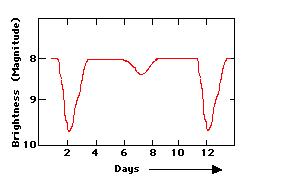Light curves
A light curve is a graph which shows the brightness of an object over a period
of time. In the study of objects which change their brightness over time such
as novae, supernovae, and variable stars, the light curve is a simple, but
valuable tool to a scientist.
When the students complete the 8 steps of Folding within their independent
practice, they will actually be creating a light curve.
If the light curve you measured looked like this plot (see below), then you
could identify your object as an eclipsing binary star. Notice that there are
"dips" in the plot. This is actually happening because the stars are
eclipsing each other. The larger "dips" occur when the smallest star
is being totally eclipsed (smallest star is behind the largest star) and the
smaller "dips" occur when the largest star is being totally eclipsed
(largest star is behind the smallest star).
We can also tell from this light curve that it takes 10 days for one of the
stars in the binary to orbit around the other one complete time. Astronomers
would say this as "the orbital period of the binary system is 10
days". Even our Earth has an orbital period. We usually call it "one
year" or "365.25 days".

| 